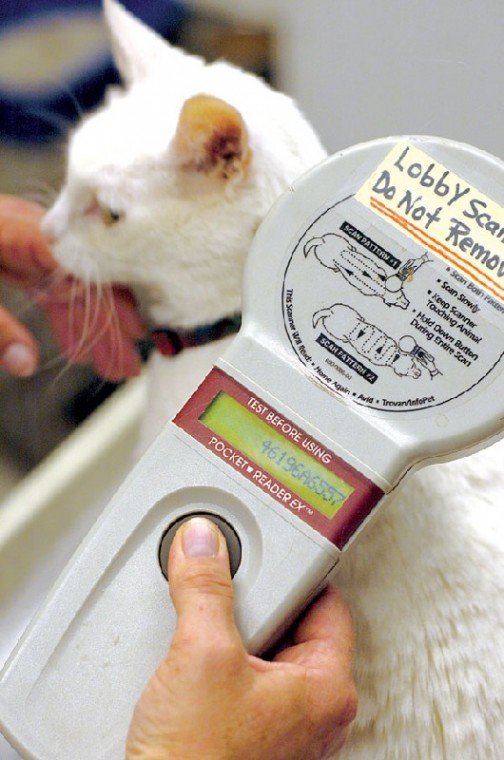Just like a small child, a pet can slip away in an instant.
When Gilroy Veterinary Hospital’s Dr. Dennis Harrigan went to
visit his college-aged son in Tuscon, Ariz., his 16-year-old
daschund-mix, Brindly, slipped out.
Just like a small child, a pet can slip away in an instant.
When Gilroy Veterinary Hospital’s Dr. Dennis Harrigan went to visit his college-aged son in Tuscon, Ariz., his 16-year-old daschund-mix, Brindly, slipped out.
Found by a couple in the area, Brindly’s rescuers were able to track Harrigan down based on his California license plates. They had noticed an 800 number on one of the tags dangling from her collar and called a microchip manufacturer, who matched the identification number on the dog’s tag to access information in the manufacturer’s central data base.
Identification can mean the difference between reunion with a lost pet and never seeing it again, but that doesn’t mean owners have to go high-tech in their quest to protect their animals.
“My life would be a lot simpler if everyone put a plain, old-fashioned collar on their animals,” said Sue Padgett, shelter clerk for the San Martin Animal Shelter. “Probably 95 percent of the animals that come in here don’t have any tags on them, but it doesn’t even have to be that complicated. You can write it on with a felt pen on a nylon collar.”
In small animals like dogs and cats, collar tags are an excellent, readily visible means of identification, said Lisa Peterson, a spokeswoman for the American Kennel Club in Manhattan. But collar tags are not a permanent ID.
Microchip identification, available nationwide through a variety of private services such as Home Again and Avid, is a low-cost way to help animal shelters, police and rescue organizations sort lost pets from feral animals, said Peterson.
The chip, which is about the size of a grain of rice, is injected under a dog or cat’s skin between its shoulder blades using a large needle, said Kim Fugate, a veterinary technician at Gilroy Veterinary Hospital. When scanned, the chip reveals a number, which corresponds to an owner’s information in the company’s database.
“You can just call up the company with the number, and they can tell you who owns the dog,” said Fugate. “You just have to keep the information current. All you have to do is call the company, say this is my ID number and let them know what you’re changing.”
Chips do have some drawbacks. They tend to wander in cats and dogs, so shelter workers must scan the animal’s entire body, said Fugate, or risk missing the chip. Also, not all scanners are compatible with one another and not all shelters and veterinarians’ offices are equipped with scanners, she said.
Tattooing is another option for cats and dogs, but among the least desirable, said Peterson, because tattoos often fade and become illegible. Also, many shelter workers often do not know where on a pet’s body to look for these markers, which may be obscured by fur, she said.
“With all these things, your pet needs to be enrolled in a national recovery service so someone knows what to do with the identification mark when they’re found,” Peterson said.
The price of injecting a chip varies among veterinarians who perform the process in the South Valley. The chip itself costs around $30, said San Martin-based veterinarian Dr. David Byerly, and central data storage for a pet’s information is usually a one-time fee of $13 to $15, according to local vets who charge between $30 and $60 to insert one. The San Jose service Tattoo-a-Pet will ink animals for as little as $10 and provide owners with a registration decal and tag for an additional $10.
In larger animals, high-tech identification has been slow to catch on. Race horses are often tattooed on the inner lip for identification purposes, but the procedure has never really caught on outside racing circles, Byerly said.
Instead, many horse owners prefer to use freeze branding, marking their equine friends with liquid nitrogen rather than a fire-hot brand or ear tag, preferred methods for most cattle owners.
“The microchips are starting to catch on,” said Byerly. “In horses, we put them in the middle of the neck, just below the mane. It’s a good spot because they don’t tend to wander, but a lot of people don’t know you can do it. With cattle, you’re more likely to see it with cattle that are a lot more valuable, like a registered cow or bull.”
Righ now, most microchipping in large animals is aimed at recovering the animals if stolen, but microchipping in large animals could become far more extensive in the near future, said Byerly.
“The USDA is moving toward trying to get as many cattle chipped as possible, just because – well, you’ve seen the news – of the current issues in the industry,” said Byerly, alluding to recent concerns over the spread of mad cow disease.
For more information on protecting your pet, call the American Kennel Club’s Companion Animal Recovery Program at (800) 252-7894 or visit them online at www.akccar.org. For tips on searching for your lost pet, visit www.petrescue.com/library/find-pet.htm.
If you travel with your pet, consider having your cell phone number rather than your home phone number stored in the animal’s identification records, said Lisa Peterson, a spokeswoman for the American Kennel Club in Manhattan. That way, if it’s lost on the road and someone contacts the microchip service, you’ll know immediately that your pet has been found.
Back yourself up with documentation, too, said San Martin-based Veterinarian Dr. David Byerly. Keep pictures and identification paperwork handy in case you need it to prove ownership of an animal, he advised.













